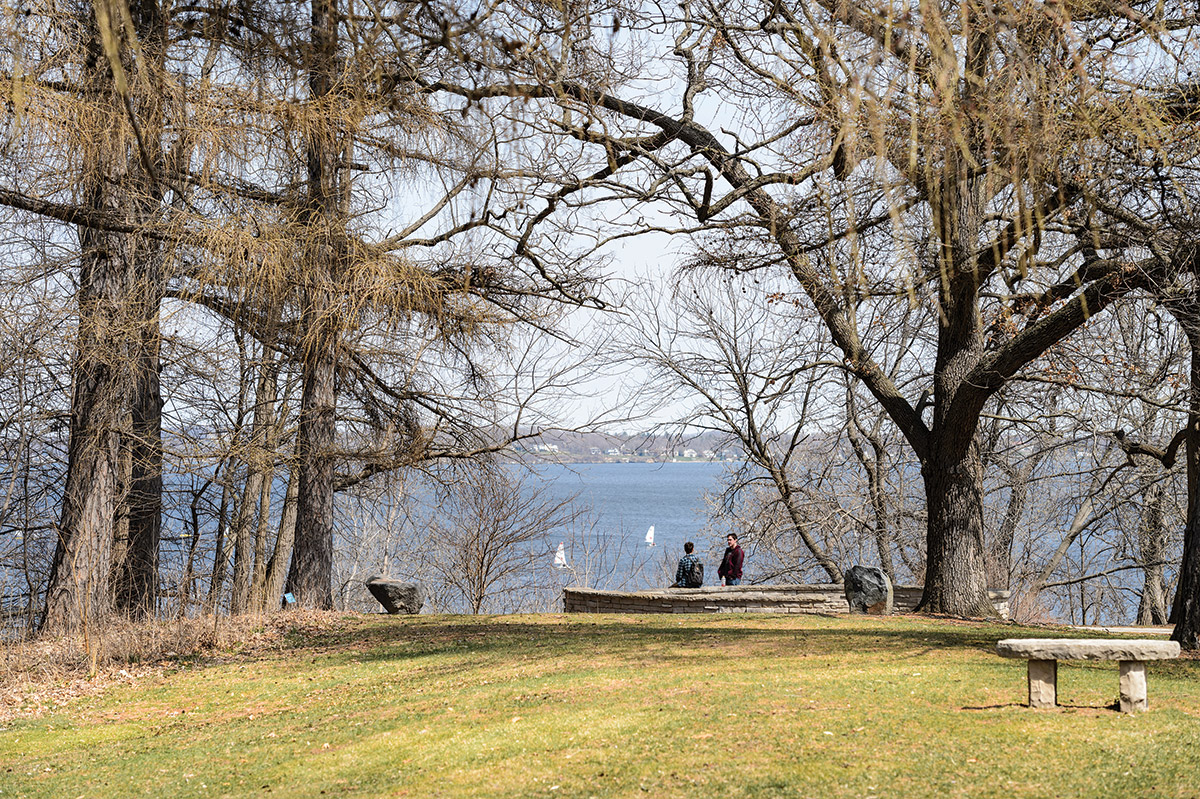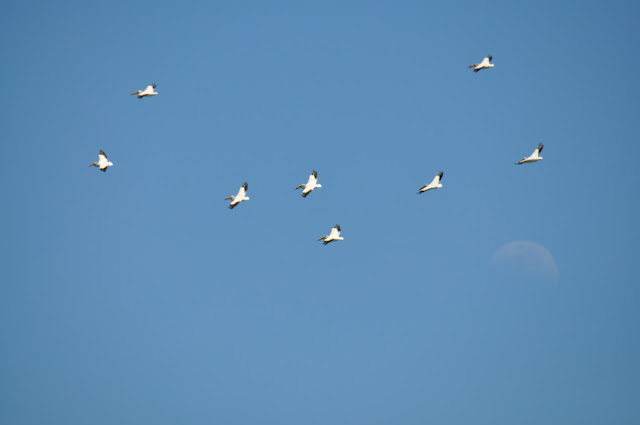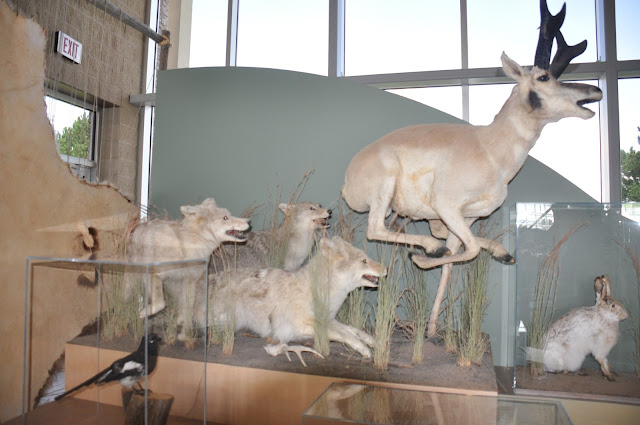The current issue of On Wisconsin, the University of Wisconsin Alumni Magazine has a picture on the back page of what it calls Muir Knoll. I certainly have memories of this hilltop on campus in Madison, but I never knew that it was called Muir Knoll, named after of course, Wisconsin's well known naturalist, John Muir. This spot on the bluff overlooking Lake Mendota is located just North and across the street from Bascom Hall, and just up the winding road from Student Union down on the Lake.

If you still can't place this spot, here is a link to youtube containing various slides of the Knoll during its recent history. It is the last slide that shows the picture I remember as a large part of my future life and it occurred on Muir Knoll.
https://www.youtube.com/watch?v=SMF3dE5IYhg
Now do you remember it? The area is just north of Bascom Hall and is really the north extension of the peak of Bascom Hill. Observatory Drive passes by this bump in the hill projecting toward Lake Mendota. The Lakeshore Path leaves this open grassy area and continues east along the shore of Lake Mendota through a woods that appropriately enough is named Muir Woods. Following Observatory Drive in its double back path to the west takes you down to the UW Theatre attached to UW Student Union at a even level with Lake Mendota.
Muir Knoll has quite a history that I was not aware of. When UW's own John Muir was a student at UW, he had his first botany lesson taught to him by a fellow student by the name of Griswold, who taught Muir to identify a black locust tree growing on the knoll along Observation Drive. Muir knew that its flowers at the time looked like pea blossoms and he couldn't understand how the members of one plant family could include the flimsy vining pea and the majesty of a black locust tree. This lesson had a significant meaning in Muir's life and he long remembered it. This north knob of Bascom Hill was dedicated as Muir Knoll in an elaborate ceremony on the site in 1918 A plaque on the Knoll marks this occasion.
In the 1920s a group of students with faculty support built a wooden ski jump from the Knoll down toward Lake Mendota and there was participation in competitions for about 10 years on that wooden jump. Later as the wood deteriorated, it was replaced by a strong steel jump, that was used off and on until it was torn down in 1953.
Also various professors would hold class outdoors in good weather on the Knoll. Best known was the "Folk Lore" meetings held by the director of the Historical Society which led to another name for Muir Knoll -- Storeyteller's Hill. The Folk Lore Meetings even preceded the ski jump era.
I suspect that Muir Knoll was always a popular love trysting spot. It is told that even the ski jump became part of such lovers' meetings. That is how I remember the Knoll. I met my future husband at the Student Union the summer before I entered Medical School at UW Madison. We spent much of that summer together as often as we could be together outside of both of our jobs -- me as a microbiologist in the Entomology Department and my boyfriend (future husband) was working two jobs, one in the physics lab and the other as the swimming pool keeper at a private dorm on Langdon Street just west of the Union. He had a second floor apartment on State Street. I was at that time living on Orchard Street near Regent with a roommate I brought along from my undergrad years at University of Iowa. I remember one night that fall as my boyfriend and I began to talk about our future, we walked up from the Union to Muir Knoll. At that time there was no stone circle there as there is now. That was created in ??. There was just the stone bench. It was a chilly fall night, but we sat on that bench and talked about what we were going to do with our relationship. Our backgrounds were so different, he from Israel and Jewish, and me nothing at the time, but certainly having been raised a Protestant. What would a marriage between us look like? We agonized over this for a couple months. But I recall that discussion beginning that night on Muir Knoll. And yes, there was a lovers' tryst between us which began at that time.
Just to let everyone know, that we finally quit agonizing over our relationship. We decided to jump into life together even though my family was very negative. We got married the following summer. And this last June 10, 2017 we celebrated our 50th Wedding Anniversary. That is why you saw a post about our Anniversary Trip to Yellowstone Park a few posts ago where we also brought our two sons and their families together with us.
Who would have thought that it all would be starting there on Muir Knoll? Life is certainly an amazing surprise. I think if we are willing to just jump into life and take a risk, at least for me and mine, things work out. There may be rough spots, but my philosophy of life says that "It always works out!"

If you still can't place this spot, here is a link to youtube containing various slides of the Knoll during its recent history. It is the last slide that shows the picture I remember as a large part of my future life and it occurred on Muir Knoll.
https://www.youtube.com/watch?v=SMF3dE5IYhg
Now do you remember it? The area is just north of Bascom Hall and is really the north extension of the peak of Bascom Hill. Observatory Drive passes by this bump in the hill projecting toward Lake Mendota. The Lakeshore Path leaves this open grassy area and continues east along the shore of Lake Mendota through a woods that appropriately enough is named Muir Woods. Following Observatory Drive in its double back path to the west takes you down to the UW Theatre attached to UW Student Union at a even level with Lake Mendota.
Muir Knoll has quite a history that I was not aware of. When UW's own John Muir was a student at UW, he had his first botany lesson taught to him by a fellow student by the name of Griswold, who taught Muir to identify a black locust tree growing on the knoll along Observation Drive. Muir knew that its flowers at the time looked like pea blossoms and he couldn't understand how the members of one plant family could include the flimsy vining pea and the majesty of a black locust tree. This lesson had a significant meaning in Muir's life and he long remembered it. This north knob of Bascom Hill was dedicated as Muir Knoll in an elaborate ceremony on the site in 1918 A plaque on the Knoll marks this occasion.
In the 1920s a group of students with faculty support built a wooden ski jump from the Knoll down toward Lake Mendota and there was participation in competitions for about 10 years on that wooden jump. Later as the wood deteriorated, it was replaced by a strong steel jump, that was used off and on until it was torn down in 1953.
Also various professors would hold class outdoors in good weather on the Knoll. Best known was the "Folk Lore" meetings held by the director of the Historical Society which led to another name for Muir Knoll -- Storeyteller's Hill. The Folk Lore Meetings even preceded the ski jump era.
I suspect that Muir Knoll was always a popular love trysting spot. It is told that even the ski jump became part of such lovers' meetings. That is how I remember the Knoll. I met my future husband at the Student Union the summer before I entered Medical School at UW Madison. We spent much of that summer together as often as we could be together outside of both of our jobs -- me as a microbiologist in the Entomology Department and my boyfriend (future husband) was working two jobs, one in the physics lab and the other as the swimming pool keeper at a private dorm on Langdon Street just west of the Union. He had a second floor apartment on State Street. I was at that time living on Orchard Street near Regent with a roommate I brought along from my undergrad years at University of Iowa. I remember one night that fall as my boyfriend and I began to talk about our future, we walked up from the Union to Muir Knoll. At that time there was no stone circle there as there is now. That was created in ??. There was just the stone bench. It was a chilly fall night, but we sat on that bench and talked about what we were going to do with our relationship. Our backgrounds were so different, he from Israel and Jewish, and me nothing at the time, but certainly having been raised a Protestant. What would a marriage between us look like? We agonized over this for a couple months. But I recall that discussion beginning that night on Muir Knoll. And yes, there was a lovers' tryst between us which began at that time.
Just to let everyone know, that we finally quit agonizing over our relationship. We decided to jump into life together even though my family was very negative. We got married the following summer. And this last June 10, 2017 we celebrated our 50th Wedding Anniversary. That is why you saw a post about our Anniversary Trip to Yellowstone Park a few posts ago where we also brought our two sons and their families together with us.
Who would have thought that it all would be starting there on Muir Knoll? Life is certainly an amazing surprise. I think if we are willing to just jump into life and take a risk, at least for me and mine, things work out. There may be rough spots, but my philosophy of life says that "It always works out!"

































































